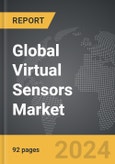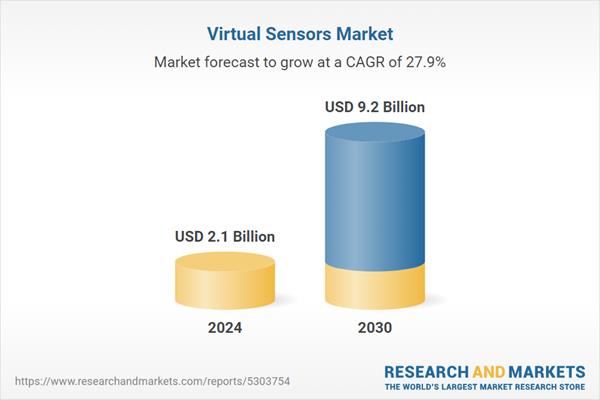Global Virtual Sensors Market - Key Trends & Drivers Summarized
What Are Virtual Sensors, and Why Are They So Crucial in Modern IoT and Industrial Applications?
Virtual Sensors are software-based models that simulate the behavior of physical sensors by using data from existing sensors, algorithms, and historical information to provide real-time monitoring and predictive insights. Unlike traditional sensors that physically measure parameters like temperature, pressure, or humidity, virtual sensors derive measurements through computational models, mathematical formulas, and data analytics. These virtual models can estimate variables that are difficult to measure directly, making them highly valuable in fields like predictive maintenance, process optimization, and smart manufacturing.The importance of virtual sensors lies in their ability to reduce hardware costs, enhance measurement accuracy, and provide insights where installing physical sensors is impractical or too costly. They are essential in IoT systems, industrial automation, automotive diagnostics, energy management, and healthcare, enabling real-time decision-making and optimization. Virtual sensors offer benefits like faster deployment, lower maintenance, and the ability to measure complex parameters by integrating multiple data sources. As industries increasingly adopt IoT and AI-driven analytics, virtual sensors have become crucial components in enabling smarter, more efficient, and cost-effective systems.
How Are Technological Advancements Shaping the Virtual Sensors Market?
Technological advancements have significantly enhanced the accuracy, versatility, and application of Virtual Sensors, driving innovation across various industries. One of the major developments is the integration of artificial intelligence (AI) and machine learning (ML) algorithms, which have improved the predictive capabilities and precision of virtual sensors. AI-powered virtual sensors can analyze large volumes of real-time data from multiple sources, identify patterns, and adapt to changing conditions, making predictions more accurate and reliable. This is particularly useful in predictive maintenance, where AI-enhanced virtual sensors can forecast equipment failures, optimize maintenance schedules, and minimize downtime.Advancements in digital twin technology have further expanded the capabilities of virtual sensors. Digital twins are virtual replicas of physical assets, processes, or systems, and virtual sensors play a critical role in these models by providing simulated data for monitoring and analysis. With digital twins, virtual sensors can simulate the behavior of equipment or processes under various conditions, allowing for scenario testing, performance optimization, and risk assessment without disrupting actual operations. This combination has proven effective in industries like manufacturing, aerospace, and energy, where high precision and operational efficiency are essential.
The rise of edge computing has also shaped the virtual sensor landscape. By processing data closer to the source, edge computing enhances the speed and responsiveness of virtual sensors, enabling real-time analytics and decision-making. Edge-based virtual sensors can operate with reduced latency, providing faster insights and localized control, which is crucial for applications like autonomous vehicles, industrial robots, and real-time quality control in manufacturing. Additionally, the integration of cloud-based analytics with virtual sensors has enabled more complex data processing, long-term trend analysis, and cross-system optimization, making virtual sensors more versatile and scalable. These technological innovations not only expand the functionality of virtual sensors but also align with broader trends toward AI-driven automation, real-time analytics, and digital transformation in modern industries.
What Are the Emerging Applications of Virtual Sensors Across Different Industries?
Virtual Sensors are finding expanding applications across a wide range of industries, driven by the need for accurate, cost-effective, and real-time monitoring and analytics. In manufacturing, virtual sensors are used to monitor equipment performance, detect anomalies, and optimize production processes. For example, they can estimate variables like product quality, vibration levels, and energy consumption based on available sensor data and predictive algorithms, enabling predictive maintenance and reducing downtime. This improves operational efficiency and reduces maintenance costs, making virtual sensors essential for smart factories and Industry 4.0 initiatives.In the automotive sector, virtual sensors are increasingly used for vehicle diagnostics, performance optimization, and advanced driver assistance systems (ADAS). By analyzing data from physical sensors, virtual sensors can estimate engine conditions, tire wear, fuel efficiency, and emissions levels. This allows manufacturers to enhance vehicle performance, improve safety, and meet regulatory compliance without adding more physical sensors. Virtual sensors also play a crucial role in autonomous vehicles, providing real-time insights into vehicle behavior, road conditions, and traffic patterns, supporting safer and more reliable autonomous driving.
In the energy sector, virtual sensors are used to monitor the performance of wind turbines, solar panels, and energy grids. They estimate parameters like wind speed, blade stress, and solar irradiance, enabling better energy output prediction and grid management. In oil & gas, virtual sensors help monitor well pressure, fluid levels, and pipeline conditions, providing early warnings of potential issues and optimizing resource extraction. In healthcare, virtual sensors are used for patient monitoring, where they estimate physiological parameters like heart rate variability, respiratory patterns, and stress levels based on existing medical data, supporting remote diagnostics and telehealth applications. The expanding applications of virtual sensors across these diverse industries highlight their critical role in enabling smarter, more efficient, and data-driven operations.
What Drives Growth in the Virtual Sensors Market?
The growth in the Virtual Sensors market is driven by several factors, including increasing adoption of IoT, advancements in AI and data analytics, and the rising demand for cost-effective and scalable monitoring solutions. One of the primary growth drivers is the proliferation of IoT devices across industries, which generates massive amounts of real-time data that virtual sensors can analyze and interpret. As industries adopt IoT for automation, efficiency, and predictive analytics, virtual sensors become essential for providing accurate insights without the need for extensive physical infrastructure, reducing deployment and maintenance costs.Advancements in AI and machine learning have significantly contributed to the adoption of virtual sensors. AI algorithms improve the accuracy, adaptability, and predictive power of virtual sensors, enabling them to identify complex patterns, predict failures, and optimize processes in real-time. This has made virtual sensors more valuable in applications that require high precision and fast response times, such as autonomous vehicles, smart grids, and industrial automation. The integration of virtual sensors with AI also supports the development of digital twins, which are increasingly used for simulation, testing, and optimization in industries like manufacturing, energy, and aerospace.
The demand for cost-effective and scalable monitoring solutions has further fueled the growth of virtual sensors. Unlike physical sensors, which require hardware installation, maintenance, and calibration, virtual sensors offer a software-based alternative that can be easily deployed, scaled, and updated across digital platforms. This makes them highly appealing to industries seeking to optimize costs while maintaining high standards of performance and reliability. Additionally, the growing focus on sustainability and efficiency has driven the adoption of virtual sensors, as they enable better resource management, reduce waste, and enhance energy efficiency.
With ongoing innovations in AI-driven analytics, digital twins, and cloud-edge integration, the virtual sensor market is poised for robust growth. These trends, combined with increasing demand for real-time, scalable, and cost-effective monitoring solutions, make virtual sensors a vital component of modern IoT, automation, and digital transformation strategies across various sectors.
Report Scope
The report analyzes the Virtual Sensors market, presented in terms of market value (US$ Thousand). The analysis covers the key segments and geographic regions outlined below.- Segments: Component (Solutions, Services); Deployment (On-Premise, Cloud); End-Use (Process Industry - Manufacturing & Utilities, Automotive & Transportation, Electrical, Electronics & Consumer Technology, Healthcare, Oil & Gas, Chemical, Aeronautics & Defense, Other End-Uses).
- Geographic Regions/Countries:World; United States; Canada; Japan; China; Europe (France; Germany; Italy; United Kingdom; and Rest of Europe); Asia-Pacific; Rest of World.
Key Insights:
- Market Growth: Understand the significant growth trajectory of the Solutions Component segment, which is expected to reach US$5.9 Billion by 2030 with a CAGR of a 27.5%. The Services Component segment is also set to grow at 28.6% CAGR over the analysis period.
- Regional Analysis: Gain insights into the U.S. market, valued at $625.3 Million in 2024, and China, forecasted to grow at an impressive 26.8% CAGR to reach $1.4 Billion by 2030. Discover growth trends in other key regions, including Japan, Canada, Germany, and the Asia-Pacific.
Why You Should Buy This Report:
- Detailed Market Analysis: Access a thorough analysis of the Global Virtual Sensors Market, covering all major geographic regions and market segments.
- Competitive Insights: Get an overview of the competitive landscape, including the market presence of major players across different geographies.
- Future Trends and Drivers: Understand the key trends and drivers shaping the future of the Global Virtual Sensors Market.
- Actionable Insights: Benefit from actionable insights that can help you identify new revenue opportunities and make strategic business decisions.
Key Questions Answered:
- How is the Global Virtual Sensors Market expected to evolve by 2030?
- What are the main drivers and restraints affecting the market?
- Which market segments will grow the most over the forecast period?
- How will market shares for different regions and segments change by 2030?
- Who are the leading players in the market, and what are their prospects?
Report Features:
- Comprehensive Market Data: Independent analysis of annual sales and market forecasts in US$ Million from 2024 to 2030.
- In-Depth Regional Analysis: Detailed insights into key markets, including the U.S., China, Japan, Canada, Europe, Asia-Pacific, Latin America, Middle East, and Africa.
- Company Profiles: Coverage of players such as Algorithmica Technologies, Andata, Aspen Technology, Cisco, Elliptic Labs and more.
- Complimentary Updates: Receive free report updates for one year to keep you informed of the latest market developments.
Some of the 36 companies featured in this Virtual Sensors market report include:
- Algorithmica Technologies
- Andata
- Aspen Technology
- Cisco
- Elliptic Labs
- Exputec
- General Electric
- Honeywell
- Intellidynamics
- LMI Technologies
This edition integrates the latest global trade and economic shifts into comprehensive market analysis. Key updates include:
- Tariff and Trade Impact: Insights into global tariff negotiations across 180+ countries, with analysis of supply chain turbulence, sourcing disruptions, and geographic realignment. Special focus on 2025 as a pivotal year for trade tensions, including updated perspectives on the Trump-era tariffs.
- Adjusted Forecasts and Analytics: Revised global and regional market forecasts through 2030, incorporating tariff effects, economic uncertainty, and structural changes in globalization. Includes historical analysis from 2015 to 2023.
- Strategic Market Dynamics: Evaluation of revised market prospects, regional outlooks, and key economic indicators such as population and urbanization trends.
- Innovation & Technology Trends: Latest developments in product and process innovation, emerging technologies, and key industry drivers shaping the competitive landscape.
- Competitive Intelligence: Updated global market share estimates for 2025, competitive positioning of major players (Strong/Active/Niche/Trivial), and refined focus on leading global brands and core players.
- Expert Insight & Commentary: Strategic analysis from economists, trade experts, and domain specialists to contextualize market shifts and identify emerging opportunities.
Table of Contents
Companies Mentioned (Partial List)
A selection of companies mentioned in this report includes, but is not limited to:
- Algorithmica Technologies
- Andata
- Aspen Technology
- Cisco
- Elliptic Labs
- Exputec
- General Electric
- Honeywell
- Intellidynamics
- LMI Technologies
Table Information
| Report Attribute | Details |
|---|---|
| No. of Pages | 228 |
| Published | January 2026 |
| Forecast Period | 2024 - 2030 |
| Estimated Market Value ( USD | $ 2.1 Billion |
| Forecasted Market Value ( USD | $ 9.2 Billion |
| Compound Annual Growth Rate | 27.9% |
| Regions Covered | Global |









